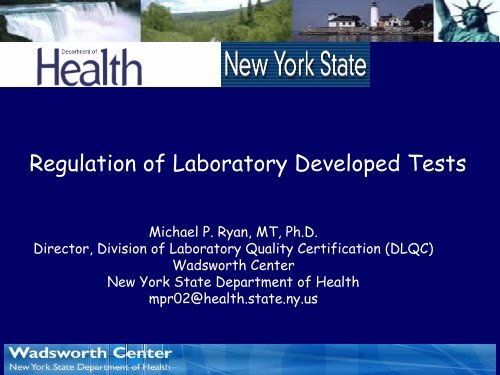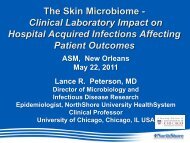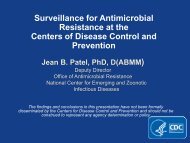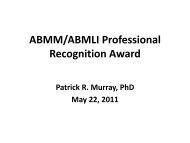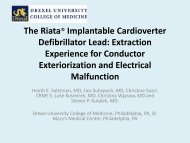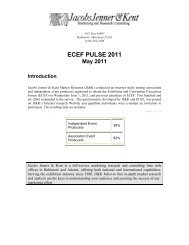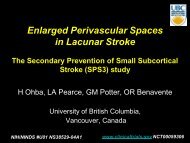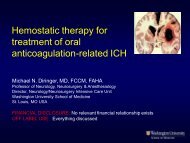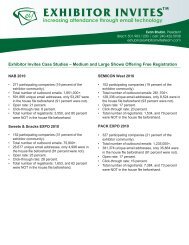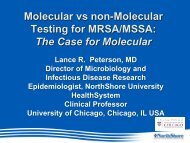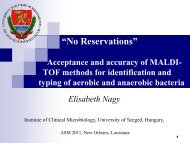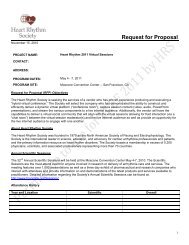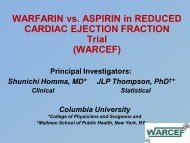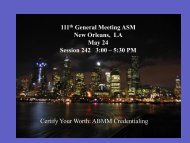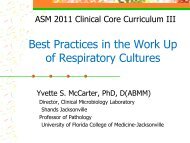Regulation of Laboratory Developed Tests
Regulation of Laboratory Developed Tests
Regulation of Laboratory Developed Tests
Create successful ePaper yourself
Turn your PDF publications into a flip-book with our unique Google optimized e-Paper software.
<strong>Regulation</strong> <strong>of</strong> <strong>Laboratory</strong> <strong>Developed</strong> <strong>Tests</strong><br />
Michael P. Ryan, MT, Ph.D.<br />
Director, Division <strong>of</strong> <strong>Laboratory</strong> Quality Certification (DLQC)<br />
Wadsworth Center<br />
New York State Department <strong>of</strong> Health<br />
mpr02@health.state.ny.us
Wadsworth Center<br />
Division <strong>of</strong> <strong>Laboratory</strong> Quality Certification<br />
(DLQC)<br />
DLQC Programs<br />
•Environmental <strong>Laboratory</strong> Approval Program (ELAP)<br />
•Blood and Tissue Resources Program (BTRP)<br />
•Physicians Office <strong>Laboratory</strong> Evaluation Program (POLEP)<br />
•Regulatory Affairs/<strong>Laboratory</strong> Investigative Unit (RA/LIU)<br />
•Breath Alcohol Permit Program (BAPP)<br />
•Regulated Medical Waste Program (RMW)<br />
•Clinical <strong>Laboratory</strong> Evaluation Program (CLEP)
Wadsworth Center<br />
Clinical <strong>Laboratory</strong> Reference System<br />
• Division <strong>of</strong> Environmental Health Sciences<br />
• Division <strong>of</strong> Genetics<br />
• Division <strong>of</strong> Infectious Disease<br />
• Division <strong>of</strong> Translational Medicine<br />
• Division <strong>of</strong> <strong>Laboratory</strong> Quality Certification
Clinical <strong>Laboratory</strong> Reference System<br />
The Department <strong>of</strong> Health's Wadsworth Center is charged with<br />
oversight <strong>of</strong> clinical laboratories and blood banks operating in New York<br />
State.<br />
This oversight is carried out through the Clinical <strong>Laboratory</strong> Reference<br />
System.<br />
Reference system activities include:<br />
•on-site surveys <strong>of</strong> facilities<br />
•pr<strong>of</strong>iciency testing <strong>of</strong> laboratories<br />
•review <strong>of</strong> laboratory personnel<br />
•reviewing and approving laboratory-developed assays
Part 58-1.10(g) <strong>of</strong> 10 NYCRR<br />
Assay Approval<br />
All technical procedures employed in a laboratory shall be <strong>of</strong><br />
proven reliability and generally accepted by leading<br />
authorities in the specialty <strong>of</strong> laboratory medicine and/or<br />
approved by the department.
Assay Approval<br />
We review assays in all disciplines <strong>of</strong> laboratory medicine<br />
including:<br />
Bacteriology<br />
Cellular immunology<br />
Clinical chemistry<br />
Cytogenetics<br />
Cytopathology<br />
Diagnostic immunology<br />
Endocrinology<br />
Fetal defect markers<br />
Forensic identity<br />
Genetics<br />
Hematology<br />
Histocompatibility<br />
HIV<br />
Immunohematology<br />
Mycobacteriology<br />
Mycology, oncology<br />
Parasitology<br />
Therapeutic substance monitoring<br />
Toxicology<br />
Virology
Assay Approval<br />
In the past 10 years, over 5,000 packages have been<br />
submitted for review.<br />
In 2009, approximately 40% <strong>of</strong> the 950 laboratories that<br />
we regulate submitted packages for review.
Scope <strong>of</strong> Reviews<br />
What type <strong>of</strong> assays require review and approval?<br />
Assays not expressly approved (PMA), cleared (510k), or<br />
exempted by the FDA, including:<br />
•Commercialized test kits variously labeled as Research<br />
Use Only (RUO) or Investigational Use Only (IUO)<br />
•<strong>Laboratory</strong> <strong>Developed</strong> <strong>Tests</strong> (LDTs) that include the use<br />
<strong>of</strong> reagents prepared by the lab and/or analyte-specific<br />
reagents (ASRs)<br />
•FDA cleared/approved tests that have been modified<br />
from their intended use
Scope <strong>of</strong> Reviews<br />
Comprehensive Test Approval Policy and Guidelines<br />
Description <strong>of</strong> Assays/<strong>Tests</strong><br />
Instructions on how to apply<br />
General Requirements for Assay Validation<br />
Guidance documents for specific scientific disciplines<br />
•Cellular Immunology<br />
•Forensic Identity<br />
•Genetic Testing-Molecular<br />
•Molecular Microbiology<br />
•Oncology-Molecular<br />
•Toxicology<br />
•Trace Elements<br />
•Cytogenetics under development<br />
(http://www.wadsworth.org/labcert/TestApproval/forms/Submission_Guidelines_Policy.pdf)
Scope <strong>of</strong> Reviews<br />
Molecular Microbiology-nucleic acid amplification assays<br />
http://www.wadsworth.org/labcert/TestApproval/forms/M<br />
icrobiology_NAAT_Checklist.pdf
Scope <strong>of</strong> Reviews<br />
Molecular Microbiology-nucleic acid amplification assays<br />
Information Reviewed:<br />
•standard operating procedure manual (SOPM)<br />
•test requisitions and reports<br />
•pertinent literature references<br />
•summary <strong>of</strong> validation studies and supporting data<br />
•plans for carrying out pr<strong>of</strong>iciency testing
Scope <strong>of</strong> Reviews<br />
Molecular Microbiology-nucleic acid amplification assays<br />
Standard Operating Procedure Manual<br />
Overview <strong>of</strong> the Assay<br />
• an overview describing the scientific basis <strong>of</strong> the test and<br />
an explanation <strong>of</strong> the assay<br />
• target gene or region being amplified with the location <strong>of</strong><br />
primers and probes<br />
• oligonucleotide list with sequences<br />
• target population <strong>of</strong> the assay and clinical validity
Scope <strong>of</strong> Reviews<br />
Molecular Microbiology-nucleic acid amplification assays<br />
Standard Operating Procedure Manual<br />
Procedure:<br />
• detailed step-by-step protocol<br />
•specimen collection, processing, storage, rejection criteria<br />
•sources <strong>of</strong> reagents and equipment<br />
•description <strong>of</strong> controls<br />
•interpretation <strong>of</strong> results<br />
•technical limitations <strong>of</strong> the assay<br />
•steps taken to minimize amplicon contamination
Scope <strong>of</strong> Reviews<br />
Molecular Microbiology-nucleic acid amplification assays<br />
Standard Operating Procedure Manual<br />
Guidance on use and preparation <strong>of</strong> controls<br />
Description <strong>of</strong> the types <strong>of</strong> controls that need to be included:<br />
•positive lysis/extraction control<br />
•negative lysis/extraction control<br />
•inhibition control<br />
•reagent contamination control
Scope <strong>of</strong> Reviews<br />
Molecular Microbiology-nucleic acid amplification assays<br />
Method Validation<br />
Data needs to be submitted that demonstrates the<br />
analytical and clinical validity <strong>of</strong> the assay.<br />
•Analytical validity means the ability <strong>of</strong> the assay to meet<br />
technical performance specifications<br />
•Clinical validity means the proven ability <strong>of</strong> an assay to<br />
reliably identify a specific condition in a test subject.
Scope <strong>of</strong> Reviews<br />
Molecular Microbiology-nucleic acid amplification assays<br />
Method Validation<br />
Summary <strong>of</strong> validation studies and results<br />
Data:<br />
•specificity<br />
•sensitivity (limit <strong>of</strong> detection)<br />
•reproducibility (inter- and intra-assay reproducibility)<br />
•accuracy verification<br />
Guidance is provided describing approaches that can be<br />
used to carry out these studies.
Scope <strong>of</strong> Reviews<br />
Molecular Microbiology-nucleic acid amplification assays<br />
Method Validation<br />
Specificity<br />
Must determine that assay does not detect related organisms,<br />
organisms producing similar illness, or organisms that may be present in<br />
specimen types to be tested.<br />
S. aureus Enterotoxin Type B<br />
Tested 69 different organisms including:<br />
• Organisms causing similar enteric illness<br />
• Genetic near neighbors<br />
• Other toxin producing S. aureus and Clostridium sp.<br />
• Select Agents<br />
* If cross-specificity is found, must be included on the patient report
Scope <strong>of</strong> Reviews<br />
Molecular Microbiology-nucleic acid amplification assays<br />
Method Validation<br />
Sensitivity (limit <strong>of</strong> detection)<br />
Data from a dilution series <strong>of</strong> a known concentration <strong>of</strong> the target<br />
(preferably whole organism) that is spiked into negative clinical samples<br />
for each matrix being validated.<br />
Perform 3 separate extractions <strong>of</strong> this dilution series and test in<br />
duplicate.<br />
The dilution series must encompass six dilutions including one below the<br />
limit <strong>of</strong> detection <strong>of</strong> the assay.<br />
If the LOD is determined to be >100 gene copies, linearity data must<br />
be provided.
Inter-assay reproducibility<br />
Scope <strong>of</strong> Reviews<br />
Molecular Microbiology-nucleic acid amplification assays<br />
Method Validation<br />
At least 3 authentic clinical samples or spiked clinical samples<br />
should be run on three different days.<br />
If spiked, the three samples should include one concentration at<br />
or near the limit <strong>of</strong> detection.<br />
Alternatively, a single positive control run repeatedly over many<br />
days (15 or more) may be used.
Intra-assay reproducibility<br />
Scope <strong>of</strong> Reviews<br />
Molecular Microbiology-nucleic acid amplification assays<br />
Method Validation<br />
At least 3 authentic clinical samples or spiked clinical samples<br />
should be run in triplicate.<br />
If spiked, the three samples should include at least one<br />
concentration at or near the limit <strong>of</strong> detection.<br />
Also, if different instruments, platforms, models or technicians<br />
will be used to perform the assay, demonstrate the assay’s<br />
consistency across these variables.
Assay Verification<br />
Scope <strong>of</strong> Reviews<br />
Molecular Microbiology-nucleic acid amplification assays<br />
Method Validation<br />
Accuracy should be verified by conducting a randomized, blinded validation<br />
study where the assay results are compared to those <strong>of</strong> a gold standard or<br />
FDA or CLEP approved assay.<br />
Provide data from at least 30 positive samples and 10 negative samples. The<br />
samples should be authentic clinical specimens, but spiked samples are<br />
acceptable when clinical specimens are not available.<br />
If spiked samples are used, at least 10 samples should be close to the LOD<br />
(maximum, 10-fold above that level).<br />
If authentic clinical samples are used, at least 10 <strong>of</strong> the 30 positives should<br />
be weak positives, if the methods used allow for this determination. Include<br />
multiple different strains and specimens.
Scope <strong>of</strong> Reviews<br />
Molecular Microbiology-nucleic acid amplification assays<br />
Method Validation<br />
Assay Verification (cont.)<br />
For quantitative assays, provide data across the full range <strong>of</strong><br />
concentrations likely to be encountered in clinical samples.<br />
Multiplex assays (especially those with multiple sample types) can<br />
present a difficult situation for the design <strong>of</strong> a validation study,<br />
since it can be a large and expensive endeavor to assay 40 samples<br />
(30positive and 10 negative) for each analyte in each specimen type.<br />
Samples can be spiked with multiple organisms, so as to reduce the<br />
number <strong>of</strong> samples required. We may be contacted for guidance<br />
prior to the submission <strong>of</strong> a package with multiplex analysis having<br />
four or more simultaneous targets.
Scope <strong>of</strong> Reviews<br />
Molecular Microbiology-nucleic acid amplification assays<br />
Method Validation<br />
Additional Guidance Provided<br />
•Broad range sequencing to identify bacteria, mycobacteria, or fungi<br />
•Subtyping using nucleic acid sequencing and comparisons to sequence<br />
databases<br />
•Prognostic viral typing assays
Acknowledgements<br />
Division <strong>of</strong> Infectious Diseases<br />
•Ron Limberger<br />
•Christina Egan<br />
•Kim Musser<br />
Clinical <strong>Laboratory</strong> Evaluation Program<br />
•Stephanie Shulman<br />
•Michael Neal<br />
Division <strong>of</strong> <strong>Laboratory</strong> Quality Certification<br />
•Kathleen Davis


